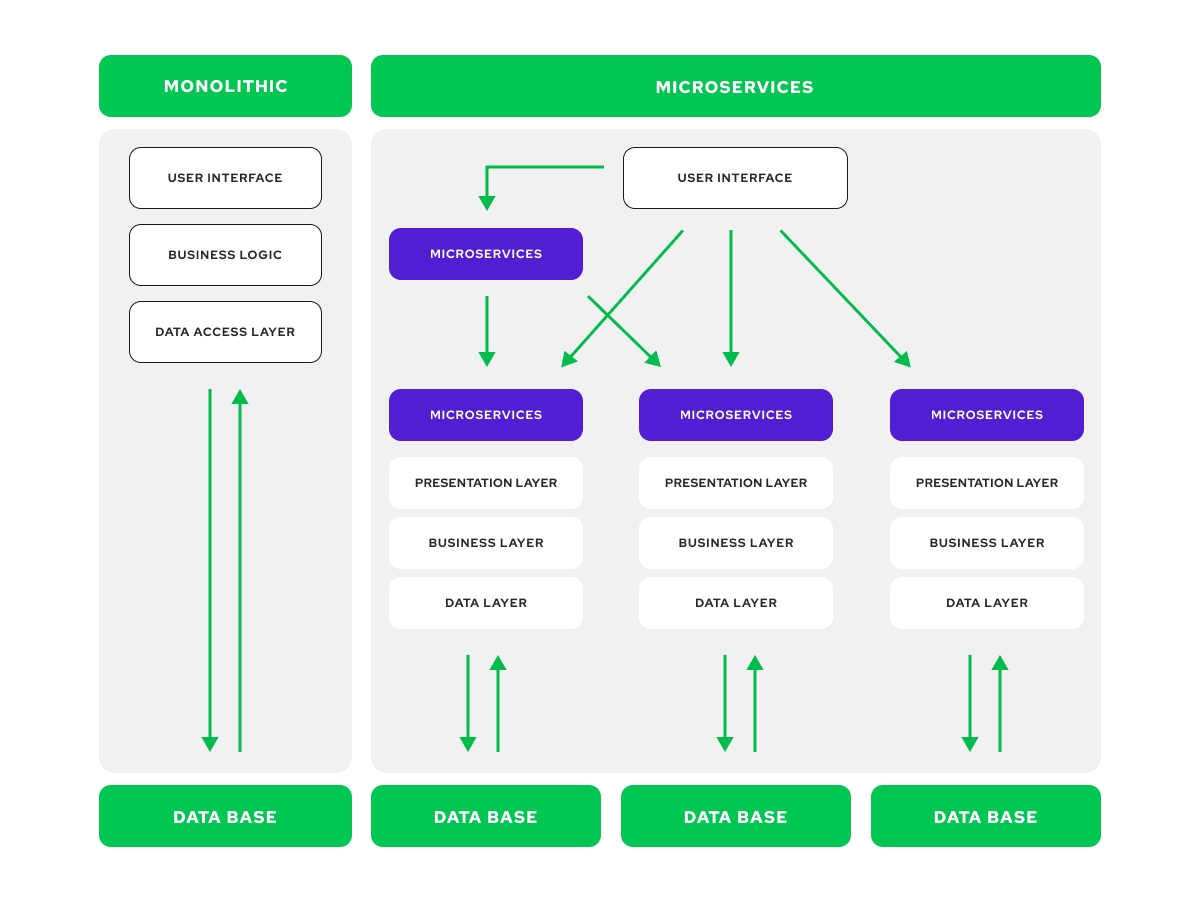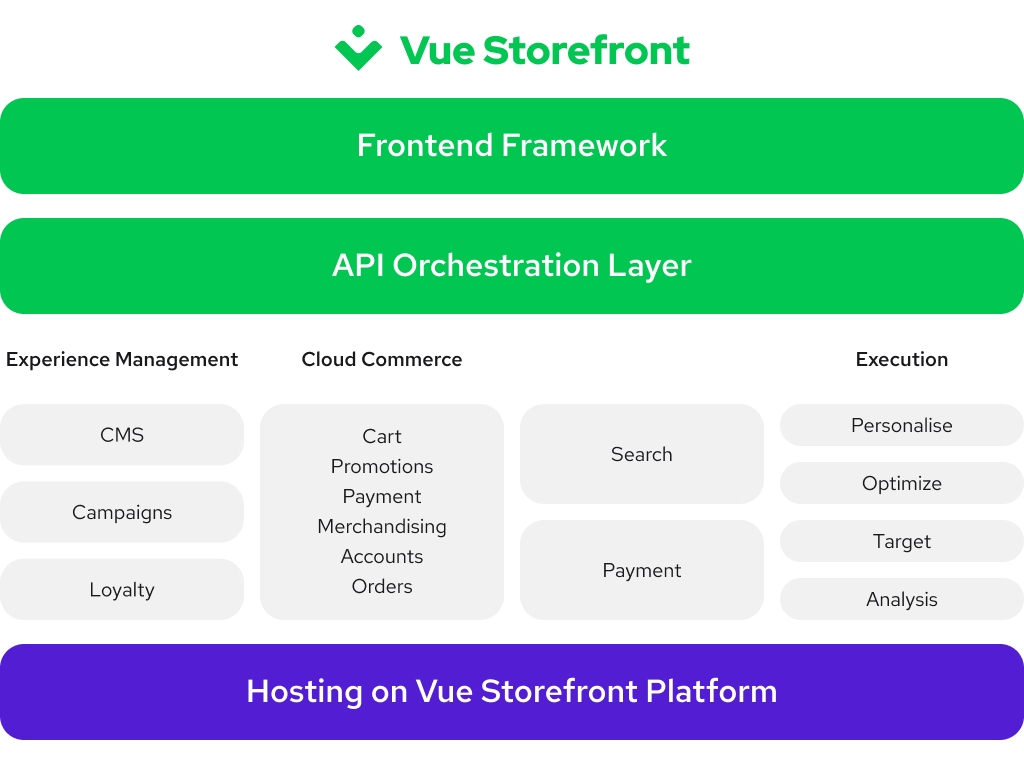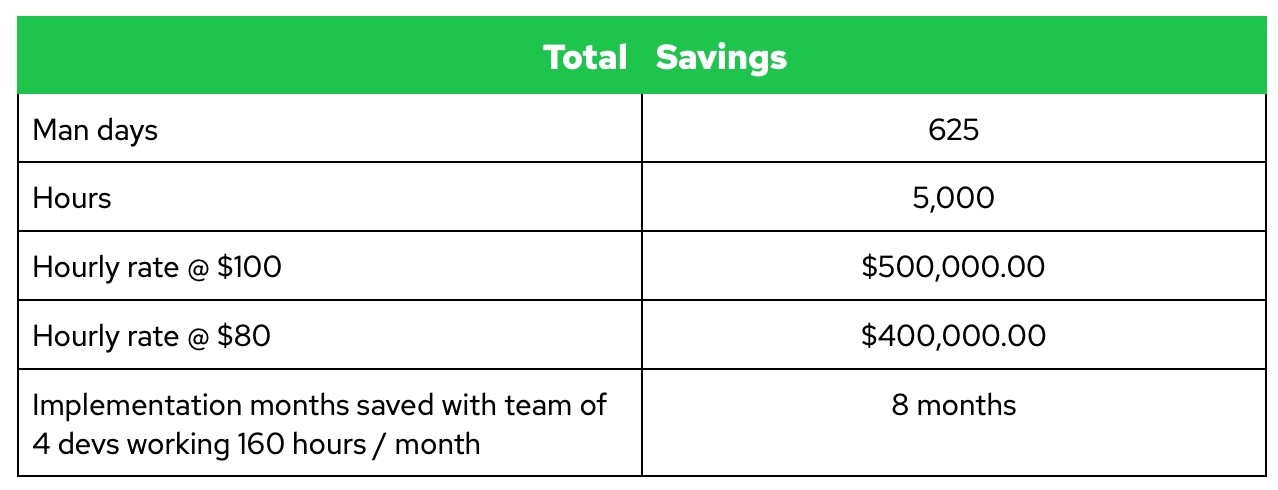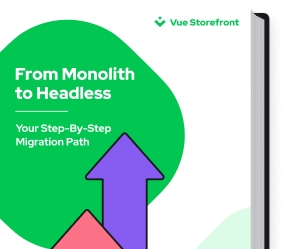Explore by Category:
Headless Commerce
From Monolith to Composable Commerce: The Ultimate Migration Guide
As the world of online shopping continues to evolve, eCommerce businesses are increasingly turning to composable commerce architectures. This shift away from legacy systems is driven by a number of factors, including the need for greater flexibility and the desire to provide a more personalized customer experience.
Understanding the benefits of changing your tech stack from monolithic to composable will explain why the rapid migration is no surprise. As eCommerce businesses continue to strive for a competitive advantage, composable commerce architectures offer a powerful way to stay ahead of the curve.
What is composable commerce?
With a composable commerce architecture, you not only decouple the frontend interface (UI/presentation layer) from the backend system (eCommerce platform, CMS, and others).
You can construct your entire tech stack from various best-of-breed microservices applications using only those elements that you need. This is one of the countless advantages of making the move to composable commerce. This gives you the ability to quickly make changes to the interface without impacting the underlying infrastructure, and updating features on any one of the composable elements is done swiftly and independently.
The most significant features of a composable commerce stack include:
- Excellent customer experiences
- Improved SEO performance
- Future-proof scalability
- Shorter Time-To-Market
- Flexibility to change and update features
- Higher and quicker ROI
- Agility
It also makes it easier to integrate with third-party applications and services. As a result, businesses that adopt a composable commerce approach are able to be more agile and responsive to changing customer needs.
Composable commerce is built with modern technologies like PWA (progressive web apps), microservices, and PBCs (packaged business capabilities), which all communicate via APIs.

Migrating vs. replatforming from monolith to composable
Today's article will explain two use cases:
A: Migrating your eCommerce system, where you follow a phased process of systematically upgrading your store while still using your existing eCommerce platform by:
- Decoupling the frontend from the backend eCommerce platform.
- Replacing your legacy storefront with a performant frontend for composable eCommerce.
- Using the Strangler method to replace and improve features and functionalities systematically.
B: Replatforming your entire eCommerce system to new composable commerce applications (PWAs, microservices, and *PBCs). The process entails:
- Building a new composable stack apart from your current commerce system.
- Transferring your data and switching over once it is tested and functional.
- An eCommerce platform migration to a new composable solution that powers your eCommerce store.
*PBCs ( Packaged Business Capabilities) are two or more microservices with ready integrations and APIs to deliver a business solution in your eCommerce architecture.
This article will provide a roadmap for your eCommerce site migration or replatforming when moving from monolith to composable or headless commerce using either of the above approaches.
Building blocks for a full composable stack
Composable Commerce refers to a decoupled architecture where the presentation layer is separated from the eCommerce platform on the backend. A full composable stack consists of various best-of-breed technologies all operating independently while communicating via APIs. In a modern composable commerce stack, there are 5 main pillars you will need:

- The frontend: The initial component of the architecture is a frontend framework. This is the presentation layer ( Storefront UI ) that will position your eCommerce platform's user interface in front of consumers to provide them with the most favorable digital user experience.
- An API orchestration layer: The API layer is the access point to all of your building blocks.
- eCommerce platform: This is the equivalent of the traditional backend of your eCommerce store. Modern solutions include BigCommerce, commercetools, Elastic Path, and other well-known software.
- CMS: A content management system, also known as a CMS, allows you to arrange your content and products on the website.
- Hosting
It's easy to add and keep services when they're modular. When maintained or updated, none of the microservices or ready integrations (PBCs) interfere with one another, making it simpler to modify and maintain. Your smaller dev or IT team only has to focus on customizations and personalizing customer journeys.
Comprehensive needs analysis for successful eCommerce replatforming or migration to composable commerce
Before entering into any external discussion with potential vendors, you must compile and document a thorough needs analysis for your business that will help you map out your migration.
All internal stakeholders and outside partners you wish to continue working with must be brought together and aligned with your primary business goals, required platform capabilities, and constraints the eCommerce site migration must address.
This process of creating a comprehensive needs analysis will help you narrow down your search for the perfect composable solution as you use it to determine whether a vendor’s capabilities can deliver what you need.
1. Why are you replatforming or migrating, and when do you want to relaunch?
This will probably be your most extensive and vital concern, as it is near to compiling an exhaustive list of must-keep elements, tools, and partners.
Make a list of your present pain points, annoyances, and restrictions. The list should include quantitative and qualitative considerations like poor conversion rates, customer dissatisfaction, wasted money and time, outages, higher overhead costs, and more. These are just a few possible issues you may want to solve by replatforming or migrating.
Also, create an expected and desired timetable for the relaunch.
2. What are your primary goals?
The three primary reasons for business growth are reducing expenses, increasing income, and enhancing efficiency. Rank them in order of importance and describe the part each goal will play in replatforming in a single sentence:
- Reduce total cost of ownership(CTO)
- Increase revenue by modernizing your tech stack
- Improve efficiency by unburdening IT
When you’re setting your objectives, keep in mind why consumers choose to buy from you. If your company goals, client preferences, and reasons for replatforming are misaligned - that is, if you invest less into what you’re great at - it might lead to disappointment and wasted time.
3. How should your platform maintain scalability at peak moments?
It is necessary to plan ahead for your store’s performance during peak seasons.
- How much traffic do you predict?
- How must your system deal with a high volume of simultaneous checkouts?
- What is your sales forecast?
4. Integrations
What third-party tools, in-house software, and outside partners would you consider “must-keep”? Which are you looking to either replace or begin implementing?
Potential integrations in a composable commerce stack
- Proprietary software
- Marketing tools
- CRM
- Retail point-of-sale
- Payment gateways
- Merchandising software
- Onsite search solution
- Multi-channel or omnichannel integrations
- Order management
- Inventory management
- Supply chain management
- Warehousing
- Shipping and fulfillment
- Enterprise resource planning (ERP)
- Analytics, ratings and reviews, recommendations, etc.
5. What sales channels do you utilize?
List your sales channels, including those beyond your business (such as email marketing and social media), and whether you use your current platform or a third party to manage them:
- Online communities
- Customer service reps (telephone or email)
- Marketplaces
- POS (brick-and-mortar retail)
- Mail-order catalogs
- Social networks
What is your present or future strategy for wholesale and B2B eCommerce ?
6. What is your current approach to global eCommerce?
List the nations, currencies, and languages you currently sell in and how you target and customize your messaging based on geography. If you don’t already have an international eCommerce strategy, note it here so that you may add it as a distinct company objective later.
7. How do you currently implement content, design, product, and UX changes?
Describe your company’s operating procedure, including the composition of the team, implementation speed, and team sizes.
8. Unique customizations or product configurations
Focus on vital and unique features to your business or current platform: e.g., pricing structures, upsells, bundles, product rules, bundles, product builders, recurring shipments, importing and exporting data, partial returns, complex variants, custom onsite search, etc.
9. Operating costs
To determine your total cost of ownership (TCO), be as thorough as possible regarding your initial AND ongoing costs of design and development (in-house or agency, servers, maintenance fees, hosting, licensing, security, CDN, etc.)
10. Competitors and other brands you follow
Compose a short list of both groups and the critical aspects from each that you appreciate most about their online or offline presence.
Migration to composable commerce: Strangling your monolith
Migrating critical components of your legacy system is a smart place to start if your primary goal is to improve the customer experience and boost performance quickly. You’ll benefit most from the beginning with the frontend (UI) as you will almost immediately improve metrics for SEO, CX, and UX. You can continue using your existing eCommerce platform while optimizing and personalizing your presentation layer (UI).
You might be holding back your migration strategy due to fear of losing existing performance and SEO metrics. With the Strangler you can focus on improving all metrics in one component and then begin to relax the rest of your stack by using composable CMSs and other third-party tools. (And, if required, replatforming to a new composable commerce platform.)
You can migrate by incrementally replatforming an application by developing a new ( Strangler ) application on top of the existing system. In this situation, the strangling software is built with a microservice architecture and has two types of services.
- Services that provide features that were previously available in the monolith.
- Services that provide new functionality.
The Strangler approach is a popular way to design and build a composable commerce stack.
The goal is to gradually "strangle" the old monolithic application by replacing it with smaller, more manageable microservices. It also allows for a smooth migration to a new architecture without needing an immediate and complete eCommerce site replatforming.
There are a few key benefits to using the Strangler approach:
- It minimizes risk by allowing for a gradual transition to the new architecture.
- It avoids the need for a complete rewrite, which can be costly and time-consuming.
- It enables you to improve the overall design of your system incrementally.
- It makes it easier to migrate data and users to the new system.
If you're considering using the Strangler approach to migrate to a composable commerce stack, there are a few things to keep in mind.
- It's crucial to clearly understand your current architecture and how it maps to the proposed microservices.
- You'll need to carefully plan your migration strategy to avoid disruptions to your business.
- You'll need to have the right team in place (SIs) to execute the migration successfully.
If you take this approach, you can choose which services to move at your own speed and when it is convenient for you. It will also give you plenty of time to discover any holes in your coverage. You may plug the gaps by including third-party microservices so that everything stays functional.
Replatforming to a composable commerce stack separate from your current monolith system
When moving from your monolithic eCommerce platform to an entire composable stack in one move, there are key considerations to keep in mind. This essential guide will help ensure a smooth transition and avoid any potential headaches down the road.
Of course, each project is unique, and we aren't suggesting a cookie-cutter strategy. Instead, the following steps are meant as a guiding principle or framework, which practical experience has shown to dramatically raise the likelihood of success.
Steps when replatforming to composable
1. Define your goals via Discovery and Gap Analysis
Before anything else, it’s essential to take a step back and define what you’re hoping to achieve by moving to a composable architecture.
- What pain points are you looking to address?
- What kind of functionality do you need?
Answering these questions upfront will save you a lot of time and effort later on.
Compile a proper needs analysis: Investigate and choose the best composable solutions for your business, including UI, API orchestration layer, eCommerce platform, CMS, hosting, and all other 3-rd party tools required like search, payments, and loyalty. Understanding your existing eCommerce situation and developing a vision for the future (which option is best) is the first step in any replatforming project. To correctly map out your new composable system, you must analyze and understand your:
- Users
- Order flow
- Products
- Integration needs
2. Analyze costs and build a business case
Replatforming costs money, but the money you have for the migration only accounts for a part of the equation. Simply verifying new API functionality will take time and money for thorough testing.
You’ll also need to consider how the new platform will influence your monthly operating expenses and how it will enable you to grow revenue.
Even if expenses are higher, you should have a compelling business case for making the switch if you can, for example, keep track of inventory more effectively, add more SKUs to your catalog, improve mobile device response times and thus boost SEO.
3. Set priorities based on your requirements
As improving business and web performance and customer experiences are the primary driving forces for replatforming from monolith to composable commerce, you should start with your frontend when replatforming as well.
Your presentation layer (UI) is the head of your composable stack. It is here where all other elements of your architecture must collaborate and function well to present your brand and business messaging to your customers.
4. Map your replatforming path and scenarios
It’s a common misconception that your website will need to go offline while replatforming to a new platform. This won’t be the case, provided it is well-planned and implemented by an experienced team.
Talk to a professional eCommerce software consultant early on in your planning to ensure you are set up for as little disruption to your business as possible.
5. Issue a Request For Proposal
Send RFPs to potential platforms. It’s a formality that states the bidding procedure and your initial terms. You may make RFPs visible to everyone on tender boards or only with your preferred group of suppliers.
The goal of issuing an eCommerce RFP is to achieve two things: To begin, you must establish your company’s objectives and requirements. Second, to formalize those goals and needs in a way that allows you to evaluate and assess prospective solutions on your terms rather than theirs.
6. Choose the right storefront, eCommerce platform, and CMS for your business
There are different composable commerce solutions on the market, so it’s imperative to choose one that’s right for your business. Consider your needs and objectives carefully before making a decision.
7. Migrate your data to the new system
Determine which data migration service you will use and when it will begin. Once you’ve chosen a composable commerce solution, you’ll need to migrate your data from the old monolithic system.
Migrating a monolithic platform to a composable one necessitates careful planning. To begin, make a timetable for transferring all of your services to your new platform in the correct order.
8. Connect your frontend with the new backend
Pair integrations, extensions, and plugins via APIs. Redesign site, relaunch in beta, and QA with stakeholders. Once your eCommerce data is in your composable CMS, you can use it to power your frontend.
This will give you a fast, reliable, and decoupled frontend that can be easily updated and maintained. Although this will usually require some development work, many off-the-shelf solutions can make the process easier.
9. Test
Before you go live with your new composable commerce system, it’s essential to test it thoroughly. This will help ensure that everything works as it should and that there are no interruptions or breakdowns when you switch over to the new system.
10. Relaunch the site publicly, and redirect URLs
Things to consider before starting your replatforming or migration journey
User Experience and SEO
Losing the organic visibility you built up over years of SEO effort is one of the most common worries among those in charge of a migration or replatforming project. Because composable commerce allows for more agile, iterative development, you can avoid such a scenario.
One of the main benefits of migrating or replatforming to a composable commerce stack is that it can improve SEO by making it easier to create and manage content. With a traditional eCommerce setup, all of the content is tightly coupled with the underlying code and database structures. This makes making changes or adding new content difficult without breaking something.
A composable commerce stack separates the frontend UI from the backend systems. This means you can easily make changes to your content without worrying about the underlying code. It also makes it easier to manage your content, as you can use any content management system (CMS) that you like. You have more control over your content and it is easier to keep your website up-to-date.
It's critical to strike a good balance between user experience and SEO for composable Commerce sites since focusing too much on UX may harm the SEO ranking while focusing too much on SEO might result in interface problems.
When the UX team redesigns a site, there might be a decrease in traffic. Users may have difficulties engaging with the site when the SEO team redesigns it. In each instance, things turn out badly.
Achieving an appropriate equilibrium is critical, and both teams must collaborate to achieve the best results.
Costs
There are a few key costs to take into account when migrating from monolith to composable commerce, which includes development costs, hosting costs, and ongoing maintenance costs.
Development Costs & TCO (total cost of ownership)
The development cost for a composable commerce platform will be higher than that of a monolithic platform due to the need to develop both the frontend and backend separately. If you don’t plan this approach well, it can lead to high TCO, which is the opposite of what you want to achieve.
But, this cost can be offset by using an OOTB (out-of-the-box) frontend for composable commerce, like Alokai, which offers an all-in-one solution that includes your storefront UI and API orchestration layer. It also has an array of ready integrations (PBCs) with all the most prominent eCommerce platforms like commercetools, BigCommerce, Elastic Path, and CMSs.
Using a code-ready frontend for composable commerce can save you up to 5,000 development hours and 8 months of development time = 400-500k USD. Alokai gives you ready architecture, components, integration APIs with 3rd party apps, and a cloud platform with Monitoring and Analytics.

Hosting Costs
Hosting costs for a composable commerce platform will also be higher than those for a monolithic platform due to the need to host both the frontend and backend separately.
This cost can be offset by using a FEaaS (Frontend as a service) platform provider such as Alokai, which offers an all-in-one enterprise solution for composable commerce which includes cloud hosting.
Ongoing Maintenance Costs
The ongoing maintenance cost for a composable commerce platform will be higher than that of a monolithic platform due to the need to maintain both the frontend and backend separately.
This cost can again be offset by using a FEaaS platform provider such as Alokai, which offers an all-in-one solution for composabel commerce with ready integrations and pre-coded PBCs (packaged business capabilities). As an enterprise client, most maintenance expenditure is covered by the licensing agreement.
Custom build frontends vs. out-of-the-box integrations
One of the significant barriers to replatforming or migrating from monolithic systems to modern composable commerce is the belief that your only choice is to custom build a frontend for your new composable stack. Fortunately, this is not the case anymore: You don’t have to build your frontend from scratch.
There are many benefits of buying an out-of-the-box frontend platform for your eCommerce business. Perhaps the most obvious benefit is that it can save you time and money. Building an eCommerce website from scratch can be very costly and time-consuming.
- Improved customer experiences. Offers, discounts, and recommendations that are more suited to customer demands encourage them to make a purchase.
- Web performance is exceptional. Modern JavaScript frameworks are used to create frontend layers, allowing you to significantly enhance performance and provide a better user experience (UX).
- The flexibility of a start-up. The risks of disrupting the entire system are generally absent when adding new features or testing new services.
- Reduced time-to-market for new features. You may quickly deploy updates to the frontend and create new features in days, not months, with a composable commerce strategy.
- You'll have complete freedom to choose the best-of-breed eCommerce solutions. The API-first architecture allows merchants to select the finest offerings in their fields and adapt their eCommerce system to suit their exact demands.
- Unlimited UX/UI control for a better Customer Experience. When units are decoupled, developers have simplified operations on the frontend without impacting the backend, allowing merchants to focus on marketing and user experience.
- Excellent omnichannel capabilities. The backend layer is not affected by changes in the presentation layer, and personalized content may be delivered from a single source across multiple touchpoints.
- Future-proofed against scaling issues. Because continuous iteration and innovation are safeguarded by composable commerce, the system is future-proofed against scalability problems.
- IT expenses are lower. Developer teams can work independently without jeopardizing the entire system. They have a lot more time to experiment and develop apps because they don't have to wait for another team to finish their work.
Finally, migrating or replatforming to an out-of-the-box frontend platform offers you built-in web performance optimizations that are ready to go as soon as you plug the application in. With features like Server Side Rendering, lazy loading and compressing images, semantic HTML code, and many more—your OOTB solution is designed with performance in mind.
With a modern frontend for composable commerce, like Alokai , you still have control over your store’s look, feel, and functionality as you would with a custom build. The customer experience and journeys are highly customizable.
The Bottom Line
If you're considering migrating from monolith to composable eCommerce, there's no need to hesitate. The process is actually quite simple and the benefits are well worth it.
With proper planning and preparation, you can make the transition smoothly and successfully. And once you're on a composable platform, you'll be able to take your business to the next level.
Share:
Share:
Frequently asked questions
More in Headless Commerce
Ready to dive in? Schedule a demo
Get a live, personalised demo with one of our awesome product specialists.






















